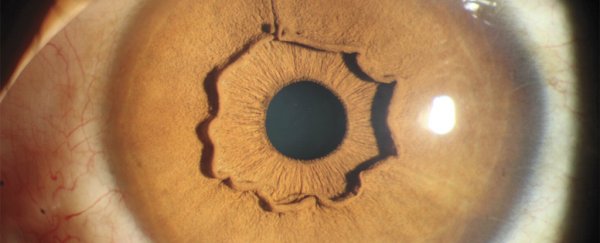Chances are you've never seen any eyeball like this before, with what looks like a horrifying growth circling the pupil at the centre.
The eyeball in question belongs to a 37-year-old Chinese woman who reported itching and watering in her eyes, problems that were eventually linked to an allergic reaction rather than the strange phenomenon you see in this image.
Having examined the woman's eyes, experts were surprised but not alarmed to see two cases of 'protruding iris collarette' staring back at them.
According to the experts though, this protruding iris collarette is actually nothing to worry about – it doesn't happen often, but it's also benign, requires no treatment, and doesn't affect vision in any way.
This finding is "a normal variant" of the condition, say the scientists from Zhongshan Ophthalmic Centre in Guangzhou, China, who studied it.
The image you can see above is the left eye, but the same condition was found in the right eye too.
"The iris collarette is a landmark that separates the central pupillary zone from the peripheral ciliary zone," explain the doctors who wrote up the case. "It is typically flat but can be prominent, as seen in this patient."
The iris collarette is the thickest part of the iris, separating the inner pupil section of the eye from the rest of the iris. It's also where the eye's sphincter and dilator muscles overlap, which control pupil size in reaction to light and other stimuli.
This collarette is also packed with radial ridges supplying the iris with blood vessels.
People with raised collarette tissue have the condition from birth, and it's not as uncommon a sight to an eye doctor as it might be to the rest of us.
But while we know what a protruding collarette is, we don't really have any idea what causes it to sometimes stick out like this.
The woman was found to still have 20/20 vision during her assessment and was given "reassurance" about this "incidental finding" before being sent home – so it's good to know the professionals aren't going to unnecessarily freak out about weird tissue growth, even if we might.
We're now heading to the mirror to take a closer look at our own eyes.
A brief report on the case has been published in the New England Journal of Medicine.
H/T Gizmodo
